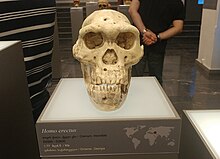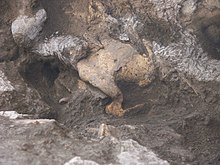Dmanisi skull 5
 Skull 5 in National Museum | |
| Catalog no. | D4500 |
|---|---|
| Common name | Dmanisi skull 5 |
| Species | Homo erectus |
| Age | 1.8 million years |
| Place discovered | Dmanisi in Georgia |
| Date discovered | 2005 |
| Discovered by | David Lordkipanidze |
The Dmanisi skull, also known as Skull 5 or D4500, is
The skull has been the cause of a paleontological controversy that is still ongoing as of 2017: many hominin fossils thought to be from different species such as Homo rudolfensis or Homo habilis may not have been separate species at all. Rather, they may have been a single evolving lineage.[2]
Discovery of the skull

In 1991, Georgian scientist David Lordkipanidze found traces of early human occupation in the cave at Dmanisi in Georgia: a hamlet and an archaeological site about 90 kilometres (56 mi) southwest of the country's capital, Tbilisi. Since then, five early hominin skulls have been discovered at the site. Skull 5, found in 2005, is the most complete specimen of them all. After further analysis, it was coupled with its mandible (D2600) found 5 years earlier. The final analysis of the discovery took many years and was only published in 2013.[1]
Description of the skull

Despite a brain volume the size of a large Australopithecus male, (546 cubic centimetres (33.3 in3)) all the characteristics of Homo erectus are clearly visible on Skull 5. The braincase sizes of the other Dmanisi skulls are between 601 cubic centimetres (36.7 in3) and 730 cubic centimetres (45 in3).[1]
The cranial superstructures of Skull 5, which are prominent and massive, suggest that it was probably a male. Its face is one of the largest of any human ancestor discovered to date.[1] The zygomatic arches are massive with the right one displaying many traces of deformations, probably due to fractures and injuries. Researchers estimate that the height of the individual was between 146 centimetres (4.79 ft) and 166 centimetres (5.45 ft) and his weight between 47 kilograms (104 lb) and 50 kilograms (110 lb).[1]
Dating
Until the 1980s, scientists assumed that
Consequently, the paleontological significance of the
Controversy and significance of the discovery
The Dmanisi skulls, especially Skull 5 with its comparatively tiny 546 cubic centimetres (33.3 in3) brain compared to
Faced with the wide variation between Skull 5 and the other
This discovery led the scientists to suggest that two species of early hominins, Homo rudolfensis and Homo habilis, were actually both Homo erectus.[2] This is an ongoing debate among the scientific community.[6]
List of Dmanisi 5 specimens
The five Dmanisi skulls are named:
- D2280 (skull 1)
- D2282/D211 (skull 2)
- D2700/D2735 (skull 3)
- D3444/D3900 (skull 4)
- D4500/D2600 (skull 5)
See also
- Homo erectus
- List of human evolution fossils
- List of human fossils
References
- ^ S2CID 20435482.)
{{cite journal}}: CS1 maint: multiple names: authors list (link - ^ a b c Skull suggests three early human species were one : Nature News & Comment
- ^ a b Wilford, John Noble (October 17, 2013). "Skull Fossil Suggests Simpler Human Lineage". The New York Times. Retrieved October 18, 2013.
- ^ Watson, Traci (October 17, 2013). "Skull discovery sheds light on human species". USA Today. Retrieved October 18, 2013.
- ^ Lahr, M.M., 2010. “Saharan Corridors and Their Role in the Evolutionary Geography of ‘Out of Africa I’”. In: A. Baden et al. (Eds.), Out of Africa I: The First Hominin Colonization of Eurasia. Springer Netherlands, 27–46.
- ^ Switek, Brian (17 October 2013). "Beautiful Skull Spurs Debate on Human History". National Geographic. Archived from the original on October 17, 2013. Retrieved 22 September 2014.
